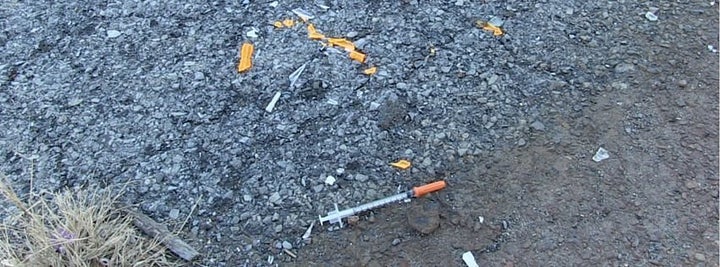A new documentary is shedding light on the thousands of residents of New York state who inject heroin in public or semi-public places, with dire consequences for their health and their communities.
"Everywhere But Safe," which will premiere this week in Manhattan, features interviews with heroin users in New York City, Albany and Schenectady, as well as in Columbia County, a more rural area upstate. Most of the people interviewed in the film have at various times injected drugs in places like hallways, subways, alleyways, parks, parked cars, restaurant bathrooms, streets and other public areas, primarily due to homelessness.
This kind of public injection, as the film makes clear, can often create a public health emergency.

Drug paraphernalia is seen lying on the street in the new documentary "Everywhere But Safe."
"If we don't come up with a plan, we're going to lose a lot of human life," one man says in the documentary's trailer. That's because people who shoot up in public spaces are statistically more susceptible to overdoses and disease.
A forthcoming report from the Injection Drug Users Health Alliance shows that a majority of needle exchange participants in New York City injected in public spaces in the past year, and were therefore more than twice as likely to have overdosed as users who didn't. They were also twice as likely not to have a steady supply of sterile injection equipment, and four times as likely to reuse injection equipment, which often leads to the transmission of disease.
“In New York, we're seeing people in our community dying of overdose, contracting HIV and hepatitis C and being pushed to the edges because of the shame and stigma associated with injection drug use,” said Taeko Frost, one of the film's two directors and the executive director of the Washington Heights CORNER Project, a needle exchange program. “As harm reduction providers, we're engaging individuals on safer drug use and providing the tools and resources to prevent overdose and transmission, but the reality is there isn't a consistent, safe space to apply these strategies."
The problems of public injection have been compounded in recent years by the sharp rise in the homeless population, particularly in New York City, and the surge in heroin use across the northeastern U.S., including in New York state.
There are at least 56,000 people in New York City sleeping in homeless shelters each night -- a near-record high, according to the latest count. And in 2013, more people in New York City died of heroin overdoses than of murder.
Meanwhile, nationwide, the number of heroin-related deaths jumped by 39 percent in 2013.
“Public injecting is real problem in New York, but fortunately it is one for which we have a clear solution supported by a large body of research,” said Julie Netherland, deputy director of the New York policy office at the Drug Policy Alliance, in a statement Monday. “Countries around the world have opened supervised injection facilities to address the kinds of public health and safety problems so poignantly illustrated in 'Everywhere But Safe.' It’s time for New York to follow the science and implement evidence-based strategies, such as SIFs, that can save lives."
Australia, Canada and some European countries operate SIFs, or supervised injection facilities, where users can inject heroin with sterile equipment in a clean environment, under professional supervision. There are currently no such facilities in the U.S.
Matt Curtis hopes "Everywhere But Safe" can help change that.
Curtis, who co-directed the film with Frost and serves as policy director at VOCAL-New York, an advocacy group that also operates a needle exchange, told The Huffington Post he hopes the documentary will "humanize" the problem of public injection and make the idea of supervised injection sites more palatable to an American audience.
“New York is not taking responsibility for this problem,” Curtis said in a statement. “We do not have to have thousands of New Yorkers injecting in public."
Creating SIFs, he said, would "remove a major public health threat, make our communities safer, and save the city money.”
It would also be a step away from the drug war's aggressive, enforcement-heavy approach to the country's heroin epidemic -- an approach in which most users are simply thrown in jail -- and a step toward what's called a "harm reduction" model. In the 1980s, under the philosophy of harm reduction, the city opened its first needle exchanges to help stop the spread of HIV. More recently, the city has equipped its police and emergency responders with naloxone, a drug that can prevent death in people who have overdosed on heroin.
"Everywhere But Safe" premieres Friday, Aug. 28, at the Maysles Documentary Center in Harlem. Curtis said the movie marks the beginning of a campaign by a new group called SIF NYC, which next month will begin a push for SIFs in the city.
CORRECTION: An earlier version of this article mistakenly identified Curtis as the executive director of VOCAL-New York. He is the group's policy director.
